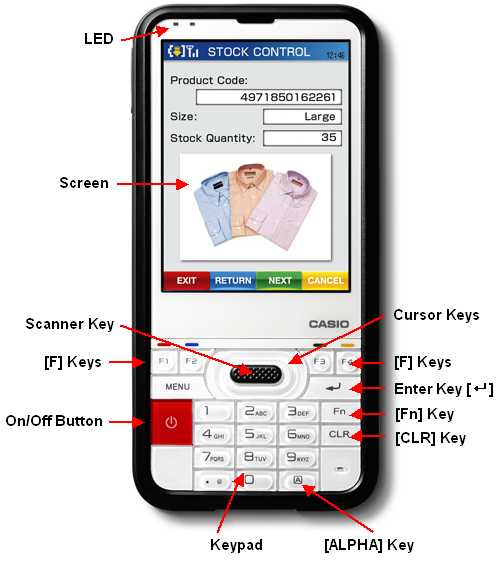
|
| Q: | SIP (Software Input Panel) |
| A: |
If you press the keys [Fn] and then [0], the SIP will be displayed or hidden, respectively. Depending on the application that is currently activated, there might also be a button displayed to toggle the SIP. You can change the type of SIP by keeping that button pressed for one or two seconds until the context menu appears. By default, the "BIG" SIP is used.
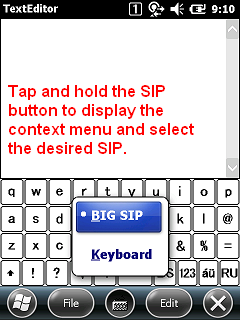
|
| A: |
If you change "Regional Settings" at START => SETTINGS => SYSTEM to one of the languages mentioned below, the "BIG" SIP can also be switched to Cyrillic by selecting "RU" (Service Pack 1.00 or later required). You can switch to English again by selecting "Aa":
- Azeri(Cyrillic)
- Russian
- Serbian (Cyrillic)
- Uzbek (Cyrillic)
|
| Q: | LED |
| A: |
Status indication with left LED for battery (green = fully charged, orange = charging) and right LED for scanner (green = success, red = error), Bluetooth (blue), PC connection (magenta) and WLAN (orange).
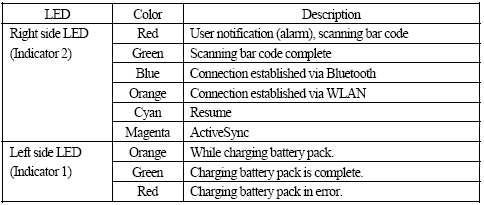
|
| Q: | Touchscreen |
| A: |
The screen reacts to touch. The input fields on the screen can either be selected with special input pen or the finger. |
| Q: | Trigger-Key |
| A: |
The scanner can read data from a label. By pressing one of the trigger-keys the scanner will be activated while the scanner software is running. Further keys can be configured if necessary. |
| Q: | Cursor-Keys |
| A: |
The cursor-keys serve in principle to change between switching surfaces represented on the screen or to move the insert mark in input fields. |
| Q: | Keypad |
| A: |
Via the keypad you enter numbers and letters. To switch between numbers and letters use the key [A]. In the status line at the upper edge of the screen the selected input method is shown symbolically. |
| Q: | [MENU]-Key |
| A: |
By pressing [Fn] + [MENU] you can select the desktop mode for your device. For further details about the CASIO Desktop Mode refer to the Active Menu User´s Guide.
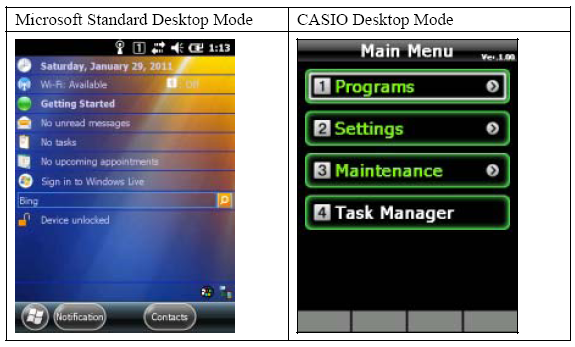
|
| Q: | Enter-Key |
| A: |
With the enter key inputs are finalised. Thus the program is instructed to accomplish the action chosen by you, for example use a selected button or store an entered number. |
| Q: | [CLR]-Key |
| A: |
The CLR-Key ("Clear"-Key) deletes the marked data in an input field, or rather the character left to the cursor. The key combination [Fn] + [CLR] leaves the actual screen if it is a simple dialogue window. |
| Q: | [Fn]-Key |
| A: |
With [Fn] - key additional input functions can be activated. In the status line at the upper edge of the screen the activated [Fn] - key is shown symbolically. By the gradual combination of an [Fn] - key and a further key you will reach the following functions:
| [Fn] + [0] |
Fade in or out the software input panel |
| [Fn] + [1] |
Switch on or off the backlight |
| [Fn] + [2] |
- |
| [Fn] + [3] |
- |
| [Fn] + [4] |
- |
| [Fn] + [5] |
Darken the backlight |
| [Fn] + [6] |
Brighten the backlight |
| [Fn] + [7] |
Starts a program (full path must be saved to Registry) |
| [Fn] + [8] |
Starts a program (full path must be saved to Registry) |
| [Fn] + [9] |
Starts a program (full path must be saved to Registry) |
| [Fn] + [.] |
Display the character "-" |
| [Fn] + [CLR] |
Output the functional character ESC |
| [Fn] + [MENU] |
Launch "System Switcher" for selecting desktop mode |
These key combinations are pre-installed and can be partly deactivated via the Registry at HKEY_LOCAL_MACHINE\HARDWARE\DEVICEMAP\KEYBD. Hint: Instead of changing the Registry you can use the "Keyboard Editor" alternatively (please see explanation and download link below).
[HKEY_LOCAL_MACHINE\HARDWARE\DEVICEMAP\KEYBD]
| Data Name |
Data Type |
Value |
Description |
| DisableFn0 |
DWORD |
0
1 |
Enables key combination (default)
Disables key combination |
| DisableFn1 |
DWORD |
0
1 |
Enables key combination (default)
Disables key combination |
| DisableFn2 |
DWORD |
0
1 |
Enables key combination (default)
Disables key combination |
| DisableFn3 |
DWORD |
0
1 |
Enables key combination (default)
Disables key combination |
| DisableFn4 |
DWORD |
0
1 |
Enables key combination (default)
Disables key combination |
| DisableFn5 |
DWORD |
0
1 |
Enables key combination (default)
Disables key combination |
| DisableFn6 |
DWORD |
0
1 |
Enables key combination (default)
Disables key combination |
| DisableFn7 |
DWORD |
0
1 |
Enables key combination (default)
Disables key combination |
| DisableFn8 |
DWORD |
0
1 |
Enables key combination (default)
Disables key combination |
| DisableFn9 |
DWORD |
0
1 |
Enables key combination (default)
Disables key combination |
| DisableFnMenu |
DWORD |
0
1 |
Enables key combination (default)
Disables key combination |
|
| Q: | [F]-Keys |
| A: |
The F-Keys [F1] to [F4] are related to their counterparts that you already from PC (VK_F1 to VK_F4). Please note that there are additional mappings defined for Windows Mobile, e.g. F1 applies to the left softkey, and F2 to the right softkey.
To easily access all softkeys from the hardware keyboard (one-hand operation), you can reconfigure the hardware keys by using functions from CASIO System Library API.
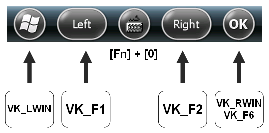
|
| Q: | [A]-Key |
| A: |
Switch between the input of numbers and letters by changing the input mode (1, A, a, or P). Remarks: P(hone) modus is not enabled by default. To enable it you can use our Keyboard Editor. |
| Q: | Key Assignment |
| A: |
Our SDK provides functions to modify the key assignment, e.g. to make country-specific settings. For that purpose you can call the method "SysSetUserDefineKey" from within your own application. |
|
| |
| Q: | Screen Lock |
| A: |
You can unlock the screen by pressing the dedicated button on the screen or the "*" on the keyboard. You can reach the "*" on the keyboard by pressing the key for the decimal pointer while in phone input mode. Please note that the phone input mode is not enabled by factory-default. You can enable it by using the SDK or the Keyboard Editor. |
| Q: | Dialog Layout |
| A: |
The OS renders each dialog box according to the number of menu entries. If a menu is used, function keys F1 and F2 are mapped to the softkeys in the taskbar at the bottom of the screen.
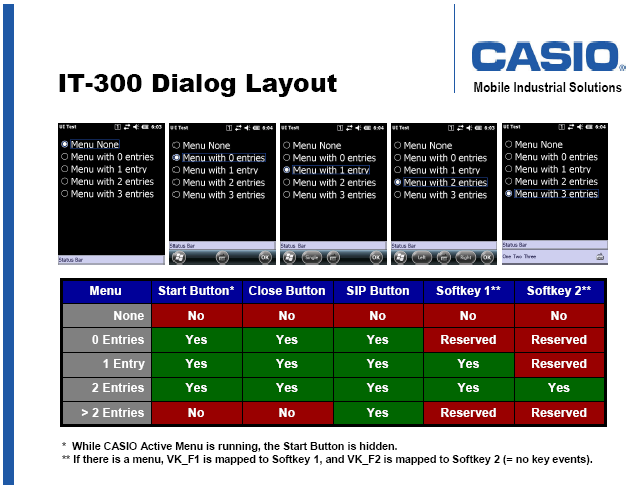
|